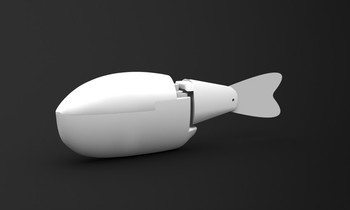This one is just screaming out for the 'fish 'n' chips' headline.
Robotic fish, developed by researchers at NYU-Poly, prove successful at inducing natural fish to follow them. In the old 'you were so busy trying to figure out how to do it, you never stopped to wonder whether you should' Jurassic Park line, the reasoning behind the research is that it could be used to lead fish away from environmental disasters.
Into the nets of commercial fish traps?
NEW YORK, March 1, 2012 – Researchers have discovered that by mimicking nature, a robotic fish can transform into a leader of live ones.
Through a series of experiments, researchers from Polytechnic Institute of New York University (NYU-Poly) aimed to increase understanding of collective animal behavior, including learning how robots might someday steer fish away from environmental disasters.
Nature is a growing source of inspiration for engineers, and the researchers were intrigued to find that their biomimetic robotic fish could not only infiltrate and be accepted by the swimmers, but actually assume a leadership role.
The researchers (Stefano Marras and Maurizio Porfiri at NYU-Poly) designed their bio-inspired robotic fish to mimic the tail propulsion of a swimming fish, and conducted experiments at varying tail beat frequencies and flow speeds.
In nature, fish positioned at the front of a school beat their tails with greater frequency, creating a wake in which their followers gather. The followers display a notably slower frequency of tail movement, leading researchers to believe that the followers are enjoying a hydrodynamic advantage from the leaders' efforts.
In an attempt to create a robotic leader, Marras and Porfiri placed their robot in a water tunnel with a golden shiner school. First, they allowed the robot to remain still, and unsurprisingly, the "dummy" fish attracted little attention. When the robot simulated the familiar tail movement of a leader fish, however, members of the school assumed the behavior patterns they exhibit in the wild, slowing their tails and following the robotic leader.

"These experiments may open up new channels for us to explore the possibilities for robotic interactions with live animals — an area that is largely untapped," explained Porfiri. "By looking to nature to guide our design, and creating robots that tap into animals' natural cues, we may be able to influence collective animal behavior to aid environmental conservation and disaster recovery efforts."
The researchers posit that robotic leaders could help lead fish and other wildlife that behave collectively — including birds — away from toxic situations such as oil or chemical spills or human-made dangers such as dams. Other experimenters have found success in prompting wildlife to move using non-living attractants, but the researchers believe this is the first time that anyone has used biomimetics to such effect.
Source: Polytechnic Institute of New York University

The aim of art is to represent not the outward appearance of things, but their inward significance. – Aristotle















